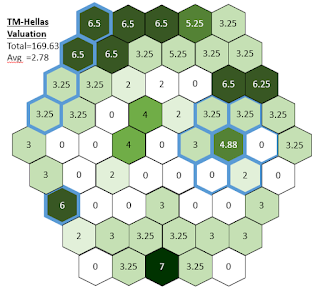All values show the Normalized values for the locations
NOTE: All images are of the Terraforming Mars Boardgame. They were graphically designed by Isaac Fryxelius, and he did an excellent job on them
Original Map
 |
 |
Mineral locations are clumped into three main areas. To the North and South Iron deposits exist. Titanium is only available on three locations, and not in any great quantity.
Cities may be built almost at any location and have access to resources. City placement is relatively easy and blocking/expansion of cities may take place just about anywhere. This leaves lots of open area to build in while the oceans in the middle effectively separate the two areas of the board.
Elysium map
Elysium is the richest of the maps, having both the most number of spaces with benefits and the largest single benefit locations ont he map. Two of the locations have a value of 9 or more. Like the Original Map, Elysium's main locations are on the equatorial belt, but the oceans do not as effectively break up the map.
The large bodies of water on the right hand side of the map effectively block expansion to the center of the map for those grabbing the "3-card" spot. It can be effective to take this location, but some other method of getting to the center of the map needs to be devised. Titanium is slightly more plentiful, and iron is much more plentiful than in the Original. Still, the total value difference between the maps is only 8.25MC, but the large value locations are definitely worth taking.
Despite this map being more plentiful in minerals and plants, placing cities is slightly more of a challenge. The lower portion of the map is a large wide open area, while the upper portion is broken up by all the ocean tiles. While most would choose to focus on the center or edges of the map to maximize resource gains, city scoring in these areas is severely restricted.
Hellas Map
Hellas poses an interesting challenge. Despite having fewer total resources, albeit not by much, it isn't effectively broken up. furthermore, some of the south pole locations offer heat, the only map to provide this benefit. Oceans on this map are either on the edge or in one large 7 hex structure just ot the right hand side.
Mineral deposits are more plentiful, while plants are more rare than the other maps, as befits the south pole. Being the South Pole of Mars, the plant locations are all on the upper edges. Furthermore, the most valuable spot on the board is arguably in the worst potential position and, though it provides a great benefit, it raises the cost of any actions there by 6. This means settling the South Pole requires a greater overall income, although the benefit is probably worth it.
Since the oceans are on edges or in one big area, this leaves the map wide open for settlement. Titanium locations are primarily on the edges of the map, while iron exists in a large clump in the center of the board. This large clumping of iron breeds competition for locations in the center of the map, despite having more total overall room to expand.




No comments:
Post a Comment